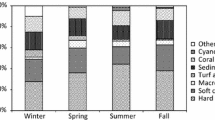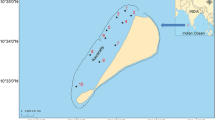Abstract
Nutrients’ concentration, phytoplankton biomass, and primary productivity were investigated in six coral atolls in the central South China Sea during the southwest monsoon in the early summer. Nutrients’ concentrations were generally very low in these atolls, and showed no obvious variation among outer reef slope, reef flat, and lagoon. The spatial variation of phytoplankton biomass and primary productivity were significant among the different regions of the atolls, and generally followed the order of outer reef slope < reef flat < lagoon. Phytoplankton biomass might be a more sensitive indicator than nutrients for the habitat differences in coral atoll ecosystem. The lagoon of Huangyan Atoll showed the highest phytoplankton biomass and primary productivity. The phytoplankton biomass and primary productivity were mainly contributed by pico-phytoplankton. Moreover, our results suggested that there might have a threshold value of Chl a for pico-phytoplankton abundance. When Chl a was higher than this threshold value (about 0.5 µg L−1), the pico-phytoplankton abundance should not linearly increase with the Chl a concentration. Due to the significantly high-phytoplankton biomass and primary productivity, the anthropogenic eutrophication should be paid attention in the lagoon of Huangyan Atoll.






Similar content being viewed by others
References
Arai T (2015) Diversity and conservation of coral reef fishes in the Malaysian South China Sea. Rev Fish Biol Fisheries 25:85–101
Asner GP, Martin RE, Mascaro J (2017) Coral reef atoll assessment in the South China Sea using Planet Dove satellites. Remote Sens Ecol Conserv 3:57–65
Bell PRF (1991) Status of eutrophication in the Great Barrier Reef lagoon. Mar Pollut Bull 23:89–93
Bell PRF, Elmetri I, Lapointe BE (2014) Evidence of large-scale chronic eutrophication in the Great Barrier Reef: quantification of chlorophyll a thresholds for sustaining coral reef communities. Ambio 43:361–376
Bellwood DR, Hughes TP, Folke C, Nyström M (2004) Confronting the coral reef crisis. Nature 429:827–833
Brodie J, De’ath G, Devlin M, Furnas M, Wright M (2007) Spatial and temporal patterns of near-surface chlorophyll a in the Great Barrier Reef lagoon. Mar Freshwater Res 58:342–353
Brodie JE, Devlin M, Haynes D, Waterhouse J (2011) Assessment of the eutrophication status of Great Barrier Reef Lagoon (Australia). Biogeochemistry 106:281–302
Burke L, Selig E, Spalding M (2002) Reefs at risk in Southeast Asia. World Resources Institute, Washington
Cao D, Cao W, Yu K, Wu G, Yang J, Su X, Wang F (2017) Evaluation of anthropogenic influences on the Luhuitou fringing reef via spatial and temporal analyses (from isotopic values). J Geophys Res Oceans. https://doi.org/10.1002/2017JC012871
Chen YLL (2000) Comparisons of primary productivity and phytoplankton size structure in the marginal regions of southern East China Sea. Cont Shelf Res 20:437–458
Delesalle B, Sournia A (1992) Residence time of water and phytoplankton biomass in coral reef lagoons. Cont Shelf Res 12:939–949
Furnas M, Mitchell A, Skuza M, Brodie J (2005) In the other 90%: phytoplankton response to enhanced nutrient availability in the Great Barrier Reef Lagoon. Mar Pollut Bull 51:253–265
Furnas M, Schaffelke B, McKinnon AD (2014) Selective evidence of eutrophication in the Great Barrier Reef: Comment on Bell et al. (2014). Ambio 43:377–378
Gardner TA, Cote IM, Gill JA, Grant A, Watkinson AR (2003) Long-term region-wide declines in Caribbean corals. Science 301:958–960
Grassshoff K, Ehrardt M, Kremling K (1983) Methods of Seawater Analysis, 2nd edn. Verlag Chemie, Weinheim
Hoegh-Guldberg O, Mumby PJ, Hooten AJ, Steneck RS, Greenfield P, Gomez E, Harvell CD, Sale PF, Edwards AJ, Caldeira K, Knowlton N, Eakin CM, Lglesias-Prieto R, Muthiga N, Bradbury RH, Dubi A, Hatziolos ME (2007) Coral reefs under rapid climate change and ocean acidification. Science 318:1737–1742
Huang LM, Wang HK, Cheng QC, Zhang JL (1997) A study on primary productivity in some coral reef lagoons of Nansha Islands. Cited in “A study on Ecological Processes of Nansha Islands Sea Area I”. Science Press, Beijing, pp 102–113 (in Chinese)
Jackson JBC, Donovan MK, Cramer KL, Lam VV (editors) (2014) Status and Trends of Caribbean Coral Reefs: 1970–2012. Global Coral Reef Monitoring Network, IUCN, Gland, Switzerland
Ke ZX, Tan YH, Huang LM, Zhang JL, Lian SM (2012) Relationship between phytoplankton composition and environmental factors in the surface waters of southern South China Sea in early summer of 2009. Acta Oceanol Sin 31(3):109–119
Ke ZX, Tan YH, Ma YE, Huang LM, Wang SB (2014) Effects of surface current patterns on spatial variations of phytoplankton community and environmental factors in Sunda shelf. Cont Shelf Res 82:119–127
Ke ZX, Liu HJ, Wang JX, Liu JX, Tan YH (2016) Abnormally high phytoplankton biomass near the lagoon mouth in the Huangyan Atoll, South China Sea. Mar Pollut Bull 112:123–133
Knap AH, Michaels AF, Close AR, Ducklow HW, Dickson AG (1996) Protocols for the Joint Global Ocean Flux Study (JGOFS) Core Measurements, vol 19. UNESCO, Paris
Larson C (2015) China’s island building is destroying reefs. Science 349:1434
Liu WY, Xie XS (1999) Space-based observations of the seasonal changes of South Asian monsoons and oceanic response. Geophys Res Lett 26:1473–1476
Mora C, Caldwell IR, Birkeland C, McManus JW (2016) Dredging in the Spratly islands: gaining land but losing reefs. PloS Biol. https://doi.org/10.1371/journal.pbio.1002422
Morton B, Blackmore G (2001) South China Sea. Mar Pollut Bull 42:1236–1263
Ning X, Chai F, Xue H, Cai Y, Liu C, Shi J (2004) Physical-biological oceanographic coupling influencing phytoplankton and primary production in the South China Sea. J Geophys Res. https://doi.org/10.1029/2004JC002365
Pandolfi JM, Connolly SR, Marshall DJ, Cohen AL (2011) Projecting coral reef futures under global warming and ocean acidification. Science 333:418–422
Parsons TR, Maita YR, Lalli CM (1984) A manual of chemical and biological methods for sea water analysis. Pergamon Press, New York
Riegl B, Glynn PW, Wieters E, Purkis S, d’Angelo C, Wiedenmann J (2014) Water column productivity and temperature predict coral reef regeneration across the Indo-Pacific. Sci Rep 5:8273. https://doi.org/10.1038/srep08273
Shen PP, Tan YH, Huang LM, Zhang JL, Yin JQ (2010) Occurrence of brackish water phytoplankton species at closed coral reef in Nansha Islands, South China Sea. Mar Pollut Bull 60:1718–1725
Slijkerman DME, de León R, de Vries P (2014) A baseline water quality assessment of the coastal reefs of Bonaire Southern Caribbean. Mar Pollut Bull 86:523–529
UNEP (2007) Reversing environmental degradation trends in the South China Sea and Gulf of Thailand. Report of the Eighth Meeting of the Regional Working Group on Coral Reefs. UNEP/GEF/SCS/RWG-CR.8/3
Uthicket S, Doyle J, Duggan S, Yasuda N, Mckinnon AD (2015) Outbreak of coral-eating Crown-of-Thorns creates continuous cloud of larvae over 320 km of the Great Barrier Reef. Sci Rep. https://doi.org/10.1038/srep16885
van Duyl FC, Gast GJ, Steinhoff W, Kloff S, Veldhuis MJW, Bak RPM (2002) Factors influencing the short-term variation in phytoplankton composition and biomass in coral reef waters. Coral Reefs 21:293–306
Vega Thurber RL, Burkepile DE, Fuchs C, Shantz AA, McMinds R, Zaneveld JR (2014) Chronic nutrient enrichment increases prevalence and severity of coral disease and bleaching. Global Change Biol 20:544–554
Vercelloni J, Caley MJ, Mengersen K (2017) Crown-of-thorns starfish undermine the resilience of coral populations on the Great Barrier Reef. Global Ecol Biogeogr 26:846–853
Wu LX, Wang HW, Lin HY, Chen QC (2001) Physical and chemical environment characteristics of Zhubi Coral Reef in Southern South China Sea. J Trop Oceanogr 20:1–7 (in Chinese)
Yu KF (2012) Coral reefs in the South China Sea: Their response to and records on past environmental changes. Sci China Earth Sci 55:1217–1229
Zhao MX, Yu KF, Shi Q, Chen TR, Zhang HL, Chen TG (2013) Coral communities of the remote atoll reefs in the Nansha Islands, southern South China Sea. Environ Monit Assess 185:7381–7392
Zhao MX, Yu KF, Shi Q, Yang HQ, Riegl B, Zhang QM, Yan HQ, Chen TR, Liu GH, Lin ZY (2016) The coral communities of Yongle atoll: status, threats and conservation significance for coral reefs in South China Sea. Mar Freshwater Res 67:1888–1896
Acknowledgements
We thank Dr. Shi Qi and Dr. Tao Shichen for their assistance in the field investigation. This work was supported by the National Key Research and Development Program of China (2017YFA0603204, 2017FY201404), the National Basic Research Program of China (2015CB452903), the National Nature Science Foundation of China (31670458), the special Fund for Agro-scientific Research in the Public Interest (201403008) and the Science and Technology Planning Project of Guangdong Province, China (2014B030301064).
Author information
Authors and Affiliations
Corresponding author
Ethics declarations
Conflict of interest
On behalf of all authors, the corresponding author states that there is no conflict of interest.
Additional information
Topic Editor Dr. Mark R. Patterson
Rights and permissions
About this article
Cite this article
Ke, Z., Tan, Y., Huang, L. et al. Spatial distribution patterns of phytoplankton biomass and primary productivity in six coral atolls in the central South China Sea. Coral Reefs 37, 919–927 (2018). https://doi.org/10.1007/s00338-018-1717-7
Received:
Accepted:
Published:
Issue Date:
DOI: https://doi.org/10.1007/s00338-018-1717-7




